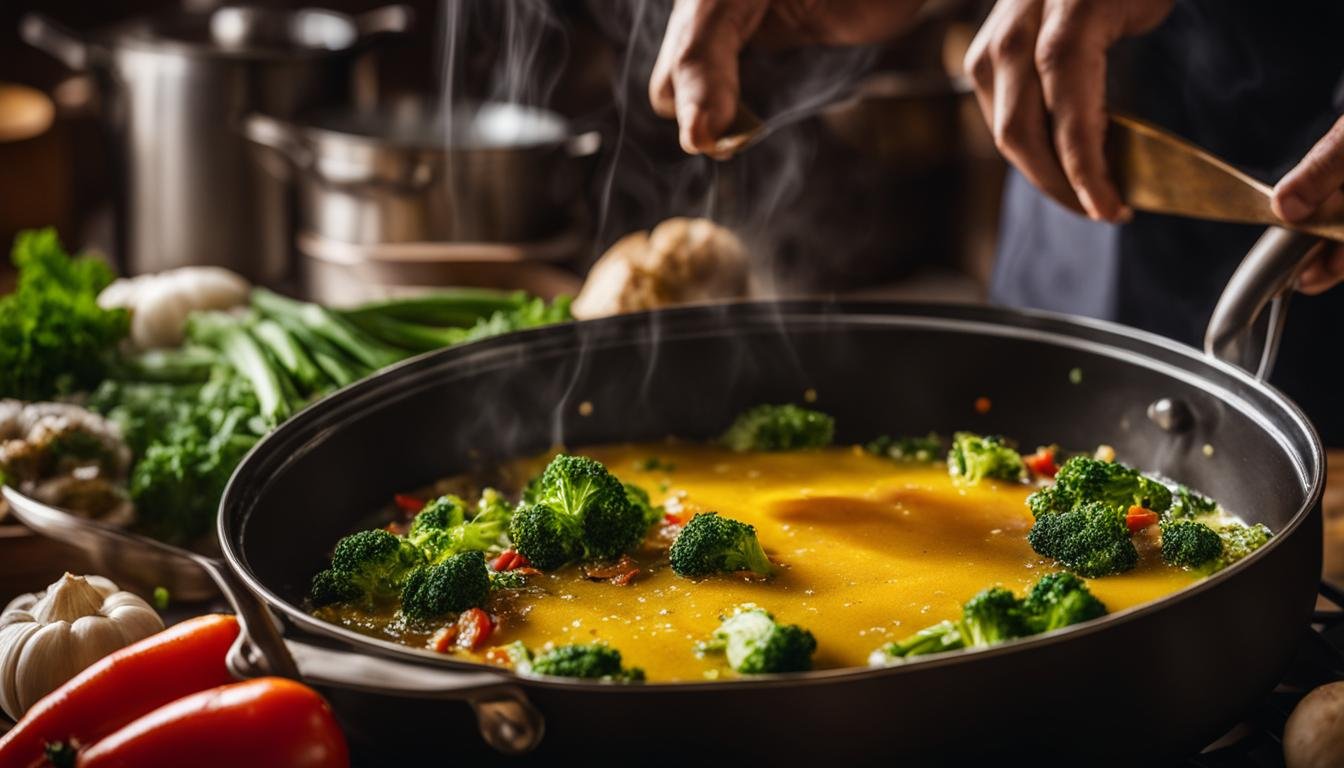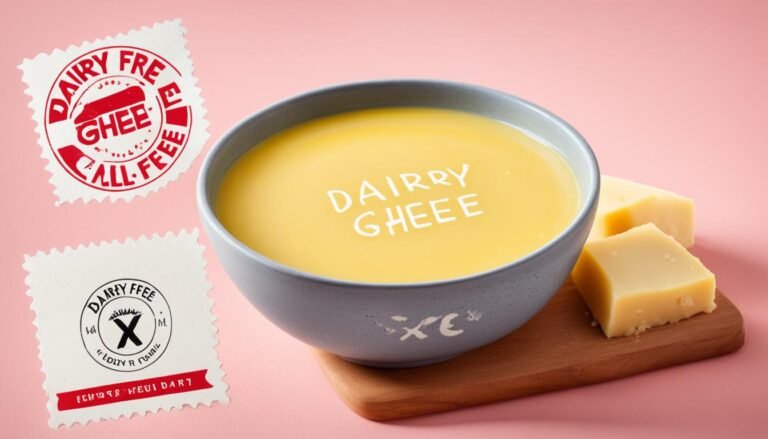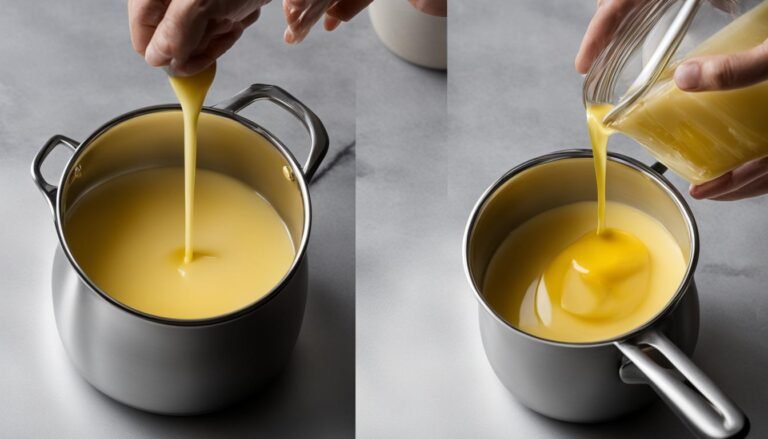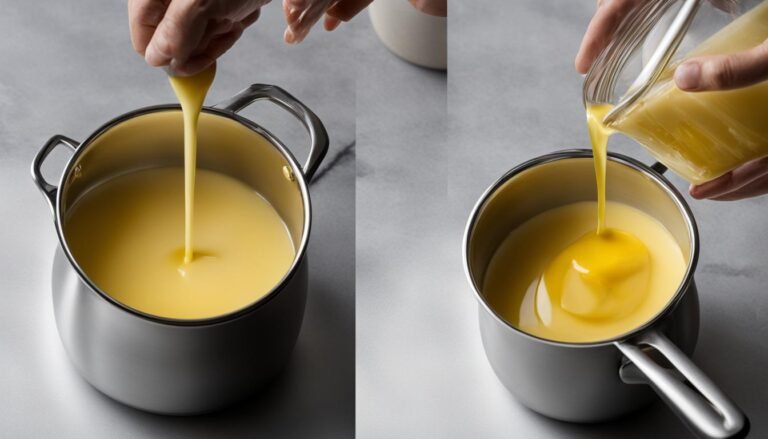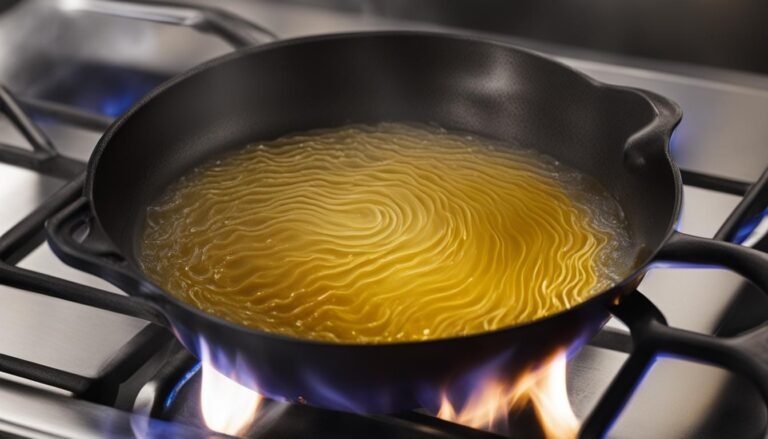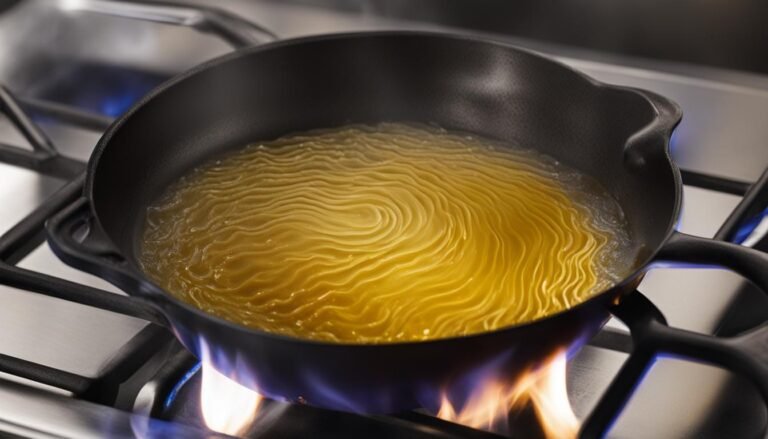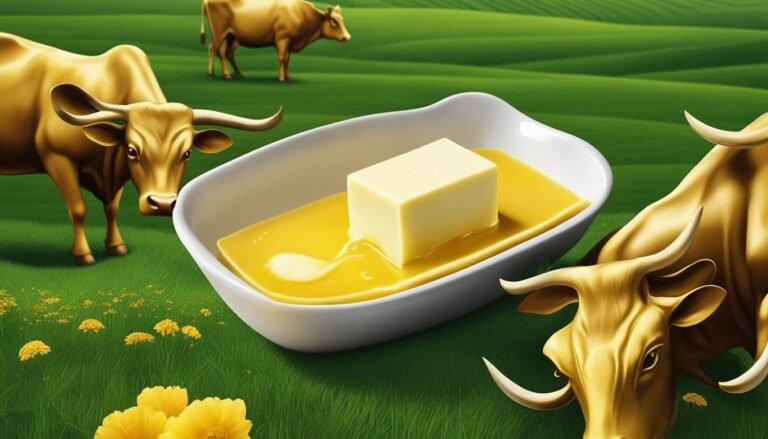Ghee 101: The Ultimate Guide to Cooking with Ghee
Welcome to our comprehensive guide to ghee, the golden elixir of Indian cuisine and a versatile ingredient that can elevate your cooking to new heights. Whether you’re a seasoned cook or a beginner in the kitchen, this ultimate guide will provide you with the knowledge and tips to master the art of cooking with ghee. From its origins and cultural significance to its nutritional profile and health benefits, we will cover it all. Get ready to enhance your flavors and embark on a delicious culinary journey with ghee!
Key Takeaways:
- Discover the rich history and cultural significance of ghee in Indian cuisine and traditional ceremonies
- Learn about the nutritional composition of ghee and its health benefits
- Explore ghee’s compatibility with various diets, including paleo, keto, and the autoimmune protocol (AIP)
- Understand the process of making ghee at home and how to store it properly
- Uncover the superior qualities of ghee in high-heat cooking and its unmistakable flavor profile
What is Ghee and How is it Made?
In this section, we will delve into the process of making ghee and clarify what exactly it is. Ghee is a type of clarified butter, which means it is made by heating butter to remove milk solids and water, leaving behind pure butterfat. This process is known as the clarification process and is essential for obtaining ghee’s unique flavor and properties.
To start the transformation from butter to ghee, the butter is melted and then simmered over low heat. As it simmers, the butter undergoes a separation process. The water content evaporates, while the milk solids float to the surface and form a layer of foam. This foam is skimmed off at regular intervals to remove the milk solids.
Once the foam has been skimmed off, the butterfat continues to simmer until it reaches a golden color. This browning process adds a delightful nutty flavor to the ghee. Finally, the ghee is carefully strained to remove any remaining milk solids, resulting in a pure and clarified butterfat.
This artisanal process of making ghee ensures the removal of milk solids and water, leaving only the smooth, rich, and flavorful essence of butter. The end result is a golden, aromatic, and shelf-stable cooking fat that is widely used in various cuisines around the world.
To get a visual representation of the clarification process, take a look at the image below:
Next, we will explore the rich history and cultural significance of ghee, shedding light on its integral role in Indian cuisine and traditional ceremonies.
The Rich History and Cultural Significance of Ghee
In this section, we will explore the rich history and cultural significance of ghee. Ghee has a long-standing presence in Indian cuisine and traditions, dating back thousands of years. It holds a special place in the hearts and stomachs of people across the country.
Ghee in Indian Cuisine and Ceremonies
Ghee is an essential ingredient in traditional Indian cooking. Its distinct aroma and nutty flavor enhance a variety of dishes, from savory curries to sweet desserts. It is used as a cooking medium, providing a rich and luscious texture to the food. Ghee is also a symbol of hospitality and is often offered to guests as a sign of respect and warmth.
Furthermore, ghee plays a prominent role in religious ceremonies and rituals in Hindu culture. It is used in religious offerings and is considered sacred. Ghee is believed to purify the mind, body, and soul, and its use in religious ceremonies holds great significance.
The Evolution of Ghee in Culinary Practices
Over centuries, ghee has evolved in culinary practices, adapting to the changing tastes and preferences of Indian cuisine. While it has deep roots in traditional recipes, ghee has also found its way into modern dishes. Chefs and home cooks alike have discovered its versatility, using it in fusion recipes and innovative creations.
Additionally, ghee has gained popularity in international cuisines, with chefs around the world incorporating ghee into their dishes. Its unique flavor and health benefits have helped it transcend borders and become a cherished ingredient in global gastronomy.
Ghee’s Role in the Hindu Caste System
Ghee has historically been associated with the Hindu caste system, which categorizes individuals into social groups based on their birth. In ancient times, ghee was primarily consumed by the upper castes, considered a symbol of wealth and prosperity. Its consumption was limited to certain sections of society and was seen as a marker of social status.
However, it is important to note that with the evolving times, the association of ghee with the caste system has become less prominent. Today, ghee is widely available and consumed by people from all walks of life, regardless of caste or social status.
Let’s take a closer look at the culinary uses of ghee and its health benefits in the next section.
Ghee 101: The Ultimate Guide To Ghee
Welcome to the ultimate guide to ghee! Whether you’re a cooking enthusiast or just starting your culinary journey, this comprehensive guide will equip you with all the knowledge you need to master the art of cooking with ghee. In this section, we will cover the basics of ghee, including its different types, shelf life, and how to choose the best quality ghee.
Ghee is a form of clarified butter that has been used in traditional Indian cuisine for centuries. It is known for its rich, nutty flavor and numerous health benefits. But before we dive into the intricacies of ghee, let’s start with the basics.
Different Types of Ghee
There are various types of ghee available, each with its unique flavor and aroma. Some popular types include:
- Desi ghee: Made from cow’s milk, desi ghee is often considered the most authentic and flavorful.
- Grass-fed ghee: Produced from the milk of cows that have been exclusively fed on grass, this type of ghee is highly prized for its nutritional value.
- Organic ghee: Derived from organic milk, this ghee is free from pesticides and other chemical residues.
When choosing ghee, opt for a reputable brand that uses high-quality ingredients and follows proper production methods.
Shelf Life of Ghee
One of the advantages of ghee is its long shelf life. Due to the removal of milk solids, ghee has a higher smoke point and can be stored at room temperature for extended periods without spoiling. Properly stored ghee can last for up to a year.
Choosing the Best Quality Ghee
When selecting ghee, there are a few factors to consider:
- Look for ghee that is made from grass-fed cows or organic milk, as these options are generally of higher quality.
- Check the manufacturing date and the shelf life mentioned on the packaging to ensure freshness.
- Read customer reviews and ratings to get an idea of the brand’s reputation and the quality of their ghee.
Remember, choosing high-quality ghee will have a significant impact on the taste and overall experience of your dishes.
“Ghee is the secret ingredient that can elevate the flavors of your cooking to a whole new level.”
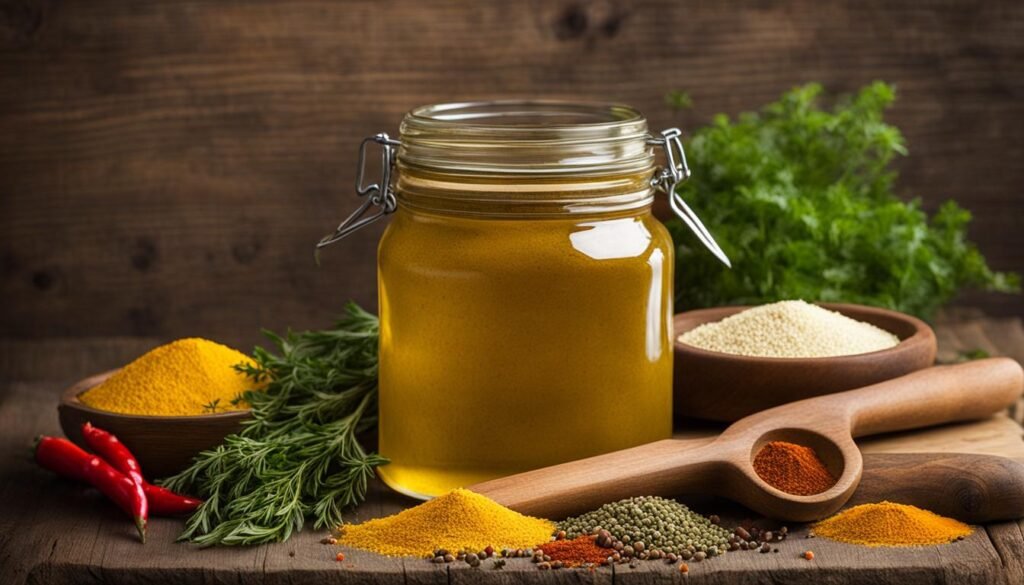
Now that we have covered the basics of ghee, let’s address some common misconceptions and answer frequently asked questions about this versatile ingredient. In the next section, we will debunk myths and provide you with all the information you need to confidently incorporate ghee into your cooking.
Understanding the Nutritional Profile of Ghee
Caloric Content and Fat Composition
Ghee is known for its rich flavor and distinctive taste, but it’s important to understand its nutritional composition as well. In terms of calories, ghee is a high-energy food. Each tablespoon of ghee contains approximately 112 calories, making it a calorie-dense ingredient.
When it comes to fat composition, ghee is primarily composed of saturated fats. These fats account for about 71-79% of its total fat content. Saturated fats have been associated with various health implications, and it’s important to consume them in moderation as part of a balanced diet.
Essential Vitamins in Ghee
Ghee also contains essential vitamins that can contribute to your overall nutritional intake. It is a rich source of fat-soluble vitamins, including vitamin A, vitamin E, and vitamin K.
Vitamin A is essential for maintaining healthy vision, supporting immune function, and promoting proper growth and development.
Vitamin E is a powerful antioxidant that helps protect cells from damage caused by free radicals. It also plays a role in supporting immune health.
Vitamin K is necessary for blood clotting and bone health. It helps maintain strong bones and plays a vital role in ensuring proper blood coagulation.
Butyrate and its Implications for Gut Health
One of the unique components of ghee is butyrate, a short-chain fatty acid that has been linked to various health benefits, particularly in terms of gut health.
Butyrate acts as a fuel source for the cells lining the gut, promoting their growth and enhancing the integrity of the intestinal barrier. This can have positive implications for digestion and overall gut health, as a healthy gut is vital for nutrient absorption and immune function.
Additionally, butyrate has been shown to have anti-inflammatory effects in the gut, which can help reduce inflammation and support a balanced immune response.
Ghee’s butyrate content makes it a unique ingredient that can contribute to a healthy digestive system and overall well-being.
| Nutrient | Amount per tablespoon (15g) |
|---|---|
| Calories | 112 |
| Total Fat | 12.7g |
| – Saturated Fat | 7.9g |
| Vitamin A | 473 IU |
| Vitamin E | 0.3 mg |
| Vitamin K | 3.3 mcg |
This table provides an overview of the nutritional content of ghee per tablespoon (15g). It highlights the caloric content, fat composition, and essential vitamin content of ghee. It’s important to note that these values may vary slightly depending on the brand and production process.
The Multifaceted Health Benefits of Ghee
In this section, we will explore the multifaceted health benefits of ghee. Ghee, a clarified form of butter, offers a wide range of advantages that make it a valuable addition to any diet. From being a lactose-free alternative to its anti-inflammatory properties and energy-boosting capabilities, ghee has much to offer.
Ghee as a Lactose-Free Alternative
Ghee is an excellent option for individuals with lactose intolerance or those following dairy-free diets. During the clarification process, the milk solids in ghee are removed, leaving behind pure butterfat. This process removes most of the lactose, making ghee a suitable substitute for butter or other dairy products.
Anti-inflammatory Properties of Butyrate
Butyrate, a type of short-chain fatty acid found in ghee, has been shown to possess anti-inflammatory properties. Inflammation is associated with various health conditions, including arthritis, heart disease, and autoimmune disorders. Consuming ghee may help reduce inflammation in the body, promoting overall well-being.
Ghee for Energy: A Metabolic Perspective
Ghee can provide a sustainable source of energy, making it ideal for individuals with active lifestyles. The medium-chain triglycerides (MCTs) found in ghee are easily digested and metabolized by the body, providing a quick source of fuel. These MCTs can enhance athletic performance and support metabolic functions.
Overall, the health benefits of ghee are vast and diverse. Its versatility as a lactose-free alternative, anti-inflammatory properties, and ability to provide sustained energy make it an excellent addition to any diet.
| Health Benefits of Ghee | Uses |
|---|---|
| 1. Lactose-free alternative | Replace butter or other dairy products for lactose-intolerant individuals |
| 2. Anti-inflammatory properties | Reduce inflammation associated with various health conditions |
| 3. Energy-boosting | Provide sustained energy for active individuals and support metabolic functions |
Clarifying the Safety of Ghee for Various Diets
When it comes to incorporating ghee into your diet, it’s important to consider its compatibility with different eating plans. In this section, we will explore the safety of ghee for three popular diets: the Paleo diet, the keto diet, and the Autoimmune Protocol (AIP).
Is Ghee Paleo-Friendly?
The Paleo diet, also known as the Paleolithic diet or the Caveman diet, focuses on consuming foods that were available to our ancestors during the Paleolithic era. This means avoiding processed foods, grains, legumes, and dairy products. While ghee is derived from dairy, it is generally considered Paleo-friendly. This is because the clarification process removes the milk solids and lactose, leaving behind only the pure butterfat. Ghee can be a suitable alternative to butter for those following the Paleo diet, as it provides a rich and flavorful cooking fat without the dairy components.
Keto Dieters Can Say Yes to Ghee
The ketogenic diet, or keto diet, is a high-fat, low-carb eating plan that aims to put the body into a state of ketosis. Ghee is an excellent choice for keto dieters due to its high fat content and negligible carb content. It provides a concentrated source of energy and can be used in various keto-friendly recipes, from sautéing vegetables to making keto-friendly desserts. Incorporating ghee into your ketogenic cooking allows you to enjoy the benefits of a flavorful fat source while staying within your desired macronutrient ratios.
Ghee’s Compatibility with the Autoimmune Protocol (AIP)
The Autoimmune Protocol (AIP) is a dietary approach that aims to reduce inflammation and immune system reactivity by eliminating potentially problematic foods. During the elimination phase of the AIP, many common cooking fats, such as vegetable oils and butter, are restricted. However, ghee is often allowed on the AIP because the clarification process removes the lactose and casein, which are common triggers for autoimmune conditions. Ghee can provide a flavorful and safe cooking fat option for individuals following the AIP.
When incorporating ghee into your diet, it’s essential to choose high-quality, organic ghee to ensure it aligns with your dietary needs. It’s also recommended to consult with a healthcare professional or registered dietitian who specializes in the specific diet you’re following to ensure ghee is suitable for your individual circumstances.

Ghee Alternatives for Paleo
| Ghee | Coconut Oil | Avocado Oil |
|---|---|---|
| Paleo-friendly | Paleo-friendly | Paleo-friendly |
| High smoke point | Medium-high smoke point | Medium-high smoke point |
| Rich flavor | Mild flavor | Mild flavor |
Table: Comparison of ghee with other paleo-friendly cooking fats
In summary, ghee can be a safe and versatile cooking fat for individuals following the Paleo, keto, and AIP diets. Its compatibility with these diets, along with its unique nutritional profile and rich flavor, make ghee a valuable addition to any healthy eating plan.
From Butter to Ghee: The Clarification Process Explained
In this section, we will explore the process of transforming butter into ghee in detail. Making ghee from butter involves a series of steps that result in the production of this clarified butterfat widely used in cooking and Ayurvedic practices.
To begin the process, start with high-quality butter. It is important to choose unsalted butter to have better control over the final flavor of the ghee. Salted butter can contain additional moisture and impurities that may affect the clarification process.
1. Melting the Butter: Start by melting the butter in a thick-bottomed pan over low heat. As the butter melts, a white foam will begin to form on the surface. Allow the butter to simmer gently for a period of time, allowing the water content to evaporate.
2. Skimming the Milk Solids: As the butter simmers, milk solids will separate and settle at the bottom of the pan. Use a slotted spoon or a fine mesh strainer to skim off these solids to achieve pure butterfat.
3. Browning and Straining: As the simmering process continues, the butter will start to turn golden and develop a nutty aroma. This browning adds depth of flavor to the ghee. Once the desired color is achieved, strain the ghee through a cheesecloth or a coffee filter to remove any remaining impurities.
4. Resulting Pure Butterfat: After the clarification process is complete, you will be left with pure butterfat, also known as ghee. Ghee has a rich, golden color, a unique nutty aroma, and a high smoke point, making it ideal for various cooking methods.
Ghee is known for its distinct flavor and versatility in culinary applications. From sautéing and frying to baking and drizzling, ghee adds a delicious richness to dishes. Additionally, ghee has a longer shelf life compared to butter due to the removal of milk solids, making it a convenient pantry staple.
Now that we’ve explored the process of transforming butter into ghee, let’s move on to the next section where we will delve into the smoking point of ghee and its superiority in cooking.
Ghee’s Smoking Point and Its Superiority in Cooking
In the world of culinary arts, understanding the smoking point of cooking oils is essential. The smoking point is the temperature at which an oil starts to break down and produce smoke. It not only affects the flavor and aroma of your dishes but also determines the safety and quality of your cooking oil.
Why High Smoke Point Matters
The smoke point of an oil is crucial, especially when you’re cooking at high temperatures or using various cooking techniques like deep frying, sautéing, or stir-frying. When an oil reaches its smoke point, it can lead to the release of harmful compounds and create an unpleasant flavor in your food.
Ghee, in particular, stands out with its high smoke point of 485°F (250°C), making it a versatile choice for high-heat cooking. Its stability at high temperatures allows you to achieve a beautiful sear on meats, crispiness in fried foods, and a perfect caramelization in sautéed vegetables while maintaining the integrity of flavors.
Comparing Ghee to Other Cooking Oils and Butters
Now, let’s compare ghee’s smoking point to other popular cooking oils and butters:
| Cooking Fat | Smoke Point |
|---|---|
| Ghee | 485°F (250°C) |
| Olive Oil | 350-410°F (175-210°C) |
| Coconut Oil | 350-425°F (175-220°C) |
| Butter | 350°F (175°C) |
| Vegetable Oil | 400-450°F (205-230°C) |
As you can see, ghee surpasses most cooking oils and even regular butter with its high smoke point. While olive oil and coconut oil have their merits, ghee stands out as a healthier and more stable option for high-heat cooking.
By using ghee in your cooking, you can confidently elevate your culinary creations to new heights, without the worry of compromising the quality or flavor of your dishes.
Step-by-Step Guide to Making Ghee at Home
In this section, we will provide a step-by-step guide to making ghee at home. By following these simple instructions, you can enjoy the rich flavor and numerous health benefits of homemade ghee.
Melting and Simmering the Butter
To begin the ghee-making process, melt unsalted butter in a heavy-bottomed saucepan over low heat. Allow the butter to slowly melt and simmer, without stirring. As the butter cooks, the water content will evaporate, and the milk solids will separate from the pure butterfat.
Skimming the Milk Solids
As the butter continues to simmer, you will notice foam starting to form on the surface. Carefully skim off the foam using a spoon or a skimmer. The foam consists of the milk solids that have risen to the top. Skimming off the foam allows you to achieve pure, clarified ghee with a smooth texture and nutty flavor.
Browning and Straining to Perfection
After skimming off the foam, the ghee will begin to develop a golden color as the milk solids continue to brown. Stir occasionally to prevent the milk solids from sticking to the bottom of the pan. Once the ghee reaches a beautiful golden hue and the milk solids turn caramel brown, it is time to strain the ghee to remove any remaining solids.
Place a fine mesh strainer or cheesecloth over a heat-resistant container and carefully pour the hot ghee through the strainer. The strainer will catch any remaining milk solids, ensuring that your ghee is pure and free from any impurities. Allow the ghee to cool at room temperature before transferring it to an airtight jar for storage.
By following these simple steps, you can create your own homemade ghee with ease. Experiment with different quantities and cooking times to personalize the flavor and consistency of your ghee. Enjoy the process of making ghee at home and savor the rich, golden goodness it adds to your favorite dishes.
Storing and Preserving Your Homemade Ghee
In this section, we will focus on storing and preserving your homemade ghee. Proper storage techniques play a crucial role in maintaining the quality and shelf life of your ghee. Whether you store it at room temperature, in the refrigerator, or freezer, we have recommendations and tips to ensure your ghee stays fresh and flavorful.
Room Temperature Storage: Do’s and Don’ts
Storing ghee at room temperature can be convenient, especially if you use it frequently and prefer it in its soft, spreadable form. However, there are some important do’s and don’ts to keep in mind:
- Do store ghee in an airtight container to prevent exposure to air and moisture, which can lead to spoilage.
- Do keep ghee away from direct sunlight and heat sources to maintain its quality.
- Do use a clean and dry spoon or utensil each time you dip into the jar to avoid introducing contaminants.
- Don’t introduce water or any moisture into the container, as it can facilitate the growth of bacteria or cause spoilage.
- Don’t store ghee in a warm or humid environment, as it can accelerate rancidity.
Extending Shelf Life with Refrigeration
Refrigerating ghee can help extend its shelf life by preventing oxidation and slowing down the growth of bacteria. Here are some recommendations for refrigerating ghee:
- Transfer your homemade ghee into a clean, airtight container before refrigerating.
- Make sure the container is sealed tightly to prevent odors from other foods in the refrigerator from being absorbed.
- Place the container in the main refrigerator compartment, away from the door where temperatures may fluctuate.
- Keep your ghee refrigerated at a temperature below 40°F (4°C) to maintain its freshness.
- Ghee stored in the refrigerator can typically last for several months, but always check for any signs of spoilage before use.
Freezing Ghee: A Long-Term Option
If you want to store your homemade ghee for an extended period, freezing is a great option. Freezing ghee can significantly prolong its shelf life. Follow these tips for freezing ghee:
- Transfer the ghee to an airtight container or freezer-safe bag.
- Label the container or bag with the date of freezing to keep track of its freshness.
- Ensure there is minimal air in the container or bag to prevent freezer burn.
- Store the ghee in the freezer set to 0°F (-18°C) or below for optimal preservation.
- When you’re ready to use the frozen ghee, allow it to thaw in the refrigerator overnight or briefly in a bowl of cold water.
- Frozen ghee can maintain its quality for up to a year when stored properly.
By following these storage tips and recommendations, you can enjoy the rich flavors and benefits of your homemade ghee for an extended period.
Conclusion
In conclusion, this ultimate guide to cooking with ghee has covered all the essential aspects of this versatile and flavorful ingredient. Whether you’re a newbie or an experienced ghee enthusiast, this comprehensive guide has equipped you with the knowledge and techniques to elevate your culinary creations.
Throughout this article, we explored the origins and cultural significance of ghee, its nutritional profile, and the numerous health benefits it offers. We learned about the clarification process and how to make ghee at home. We also discussed the compatibility of ghee with various diets and its superiority in high-heat cooking.
By understanding the importance of ghee’s smoking point, you can enhance the flavors and quality of your dishes. Additionally, we provided guidance on how to store and preserve homemade ghee to ensure its longevity and freshness.
Now armed with this knowledge, you can confidently incorporate ghee into your cooking, whether it be in traditional Indian recipes or as a healthier alternative in your favorite dishes. So go ahead and explore the wonderful world of ghee to unlock new levels of flavor and culinary delight.
FAQ
Should ghee be refrigerated?
Ghee can be stored at room temperature for up to several months, as long as it is stored in an airtight container and kept away from direct sunlight and heat sources. Refrigeration is not necessary for ghee, but it can extend its shelf life.
How do I choose the best ghee?
When choosing ghee, look for organic, grass-fed varieties that are free from additives and preservatives. A golden color and a rich aroma are indicators of high-quality ghee.
Is ghee bad for cholesterol?
Ghee is high in saturated fat, which can raise LDL (bad) cholesterol levels if consumed in excess. However, ghee also contains butyrate, which has been shown to have beneficial effects on cholesterol levels.
What is the best way to use ghee?
Ghee can be used in a variety of ways, including sautéing, frying, baking, and even spreading on toast. Its rich, nutty flavor enhances the taste of dishes and adds depth to recipes.
Your ultimate guide to ghee ingredients?
The only ingredient in ghee is butter. During the clarification process, the milk solids and water are removed, leaving behind pure butterfat.
Your ultimate guide to ghee – how to use it?
Ghee can be used as a cooking oil or butter substitute. It has a high smoke point, making it ideal for high-heat cooking. Ghee can also be used in baking, spreading on toast, or adding flavor to dishes.
When should ghee be avoided?
Ghee should be avoided or consumed in moderation by individuals who have a dairy allergy or are lactose intolerant. It is also high in calories and saturated fat, so it should be consumed in moderation for those watching their weight or managing their cholesterol levels.
What is the healthiest way to consume ghee?
The healthiest way to consume ghee is to use it in moderation as part of a balanced diet. It is best to opt for organic, grass-fed ghee and incorporate it into a variety of dishes for its rich flavor and potential health benefits.
Which butter is better for ghee?
When making ghee, it is ideal to use unsalted butter made from high-quality cream. Grass-fed or organic butter is often considered to be the best choice for making ghee.

